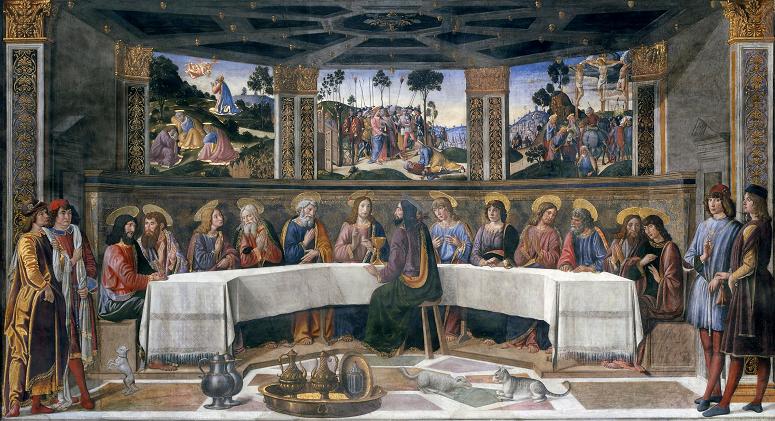Last Supper. The Last Supper of Jesus and the Twelve Apostles has been a popular subject in Christian art, often as part of a cycle showing the Life of Christ. Depictions of the Last Supper in Christian art date back to early Christianity and can be seen in the Catacombs of Rome. The Last Supper was depicted both in the Eastern and Western Churches. By the Renaissance, it was a favorite subject in Italian art. It was also one of the few subjects to be continued in Lutheran altarpieces for a few decades after the Protestant Reformation. There are two major scenes shown in depictions of the Last Supper: the dramatic announcement of the betrayal of Jesus, and the institution of the Eucharist. After the meal the further scenes of Jesus washing the feet of his apostles and the farewell of Jesus to his disciples are also sometimes depicted. The earliest known written reference to the Last Supper is in Paul's First Epistle to the Corinthians, which dates to the middle of the first century. The Last Supper was likely a retelling of the events of the last meal of Jesus among the early Christian community, and became a ritual which referred to that meal. The earliest depictions of such meals occur in the frescoes of the Catacomb of Rome, where figures are depicted reclining around semi-circular tables. In spite of near unanimous assent, the historicity of the evidence, one lone scholar comments that The motif of the Last supper appears neither among the paintings of the catacombs nor the sculptures on sarcophagi. The few frescos in the catacombs representing a meal in which Christ and some of the disciples participate show not the Last supper but refer to the future meal promised by the exalted Christ in his heavenly kingdom, seeing the subject as beginning to be depicted in the 6th century. A clearer case is the mosaic in the Church of Sant' Apollinare Nuovo in Ravenna, Italy, where a similar meal scene is part of a cycle depicting the life of Jesus and involves clear representation of him and his disciples. Byzantine artists sometimes used semi-circular tables in their depictions, but more frequently they focused on the Communion of the Apostles, rather than the reclining figures having a meal. The Last Supper was also one of the few subjects to be continued in Lutheran altarpieces for a few decades after the Protestant Reformation, sometimes showing portraits of leading Protestant theologians as the apostles. By the Renaissance, the Last Supper was a favorite subject in Italian art, especially in the refectories of monasteries. These depictions typically portrayed the reactions of the disciples to the announcement of the betrayal of Jesus. Most of the Italian depictions use an oblong table, and not a semi-circular one, and sometimes Judas is shown by himself clutching his money bag. With an oblong table, the artist had to decide whether to show the apostles on both sides, so with some seen from behind, or all on one side of the table facing the viewer. Sometimes only Judas is on the side nearest the viewer, allowing the bag to be seen. The placement on both sides was further complicated when halos were obligatory; was the halo to be placed as though in front of the rear-facing apostles faces, or as though fixed to the back of their head, obscuring the view? Duccio, daringly for the time, just omits the halos of the apostles nearest the viewer. As artists became increasingly interested in realism and the depiction of space, a three-sided interior setting became more clearly shown and elaborate, sometimes with a landscape view behind, as in the wall-paintings by Leonardo da Vinci and Perugino. Artists who showed the scene on a ceiling or in a relief sculpture had further difficulties in devising a composition. Typically, the only apostles easily identifiable are Judas, often with his bag containing thirty pieces of silver visible, John the Evangelist, normally placed on Jesus's right side, usually reclining in Jesus' bosom as his Gospel says, or even asleep, and Saint Peter on Jesus's left. The food on the table often includes a paschal lamb; in Late Antique and Byzantine versions fish was the main dish. In later works the bread may become more like a communion host, and more food, eating, and figures of servers appear. There are two major episodes or moments depicted in Last Supper scenes, each with specific variants. There are also other, less frequently depicted scenes, such as the washing of the feet of the disciples. The first episode, much the most common in Western Medieval art, is the dramatic and dynamic moment of Jesus' announcement of his betrayal.
more...














